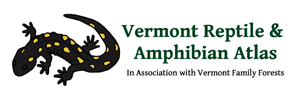There are many gaps in our knowledge of reptiles and amphibians in Vermont. You can help fill in those gaps. Here are a few examples of information we would like to have.
We still cannot be confident that our total Vermont reptile and amphibian species list is accurate. The relocation of the Boreal Chorus Frog in Alburg in 1998 put the number of species at 40. It was heard again in 1999 but has not been seen or heard in Vermont since then. It may be extirpated from the state. Is it still here? It may not be long before the first population of Marbled Salamanders, Blanding’s Turtles, Eastern Box Turtles, or Eastern Hog-nosed Snakes, are documented in this state.
We would like to be able to generate a complete and accurate species list for every town in Vermont and we continue to work toward that goal. But whether or not a species has been previously reported from a given town, I urge people to report a species the first time they see it. This is in part because we are interested in gathering newer or better-documented reports even from towns that have been well surveyed. Old reports will eventually become historic reports. Consequently, they need to be updated. If you have not reported a given species from a site for over ten years, and it is still there, please update the record. If you did not photograph it last time, you could try to photograph it this time.
Rare species (state ranks S1-S3, see tables) should be reported every time they are seen. As you would expect, we have the largest gaps in our knowledge of these species.
The Fowler’s Toad is one of the amphibians we know very little about. Though we have scattered individual or old reports from a few towns, we currently know of only one population of this species. Most Vermonters are unaware that we have two species of toads in our state. Listen to their call. It is quite distinctive. Can you find a population?
The Spotted Turtle (a diminutive species with yellow spots on its shell) is listed as an endangered reptile in Vermont. Only one population of this species was known until 2010 when a large population was discovered in a separate county. Are there more populations that we have yet to find or is it really absent from most of Vermont?
Any large black snake is an important record, whatever species it may be. It could be a Central Ratsnake (currently known only from west central Vermont), a North American Racer (not reported in Vermont since 2024), the black phase of a Timber Rattlesnake (only two known denning areas remaining) or an adult Common Watersnake (scattered reports).
Take a look at the full list of the “most wanted and rarest” species . Or explore some maps showing what towns are undersurveyed.
Many other questions remain unanswered. Does the Spiny Softshell (turtle) ever travel south of the Lake Champlain Bridge? Did the Allegheny Mountain Dusky Salamander make it across the Hudson River drainage and Lake Champlain into Vermont? Is the Common Five-lined Skink found anywhere other than in West Haven or Benson? What’s really going on with the unconfirmed species?
In addition to questions about the distribution of the rarer species listed above, we still have unanswered questions about the distribution of the more common species. Is the Eastern Milksnake really missing from Essex and Orleans Counties? Is the Northern Leopard Frog really missing from Bennington and Windham Counties? (Take a look at our current list of these “missing” species.)
We are also very interested in gathering natural history observations, such as the first or last date of calling for frogs, the first sightings of snakes or turtles in the spring, when and where you see turtles laying their eggs, salamanders crossing the roads, snakes denning, or salamanders breeding.
These are just a few examples of the many things we would like to know more about. If you are interested in looking for amphibians and reptiles, we have some Basic Search Tips for these animals.

